Financial Accounting Assignment: Anti-Tax Avoidance Rules in Australia
VerifiedAdded on 2023/06/03
|14
|3821
|204
Report
AI Summary
This financial accounting assignment report critically evaluates the Anti-Tax Avoidance rules in Australia, focusing on the re-evaluations used to address tax avoidance. The report begins with an abstract summarizing the key findings and then delves into the introduction, which outlines the importance of taxation for organizations and the implementation of General Anti-Avoidance Rules (GAAR). The background information provides context on tax avoidance practices and the government's response. The core of the report lies in the analysis and theoretical application, where two theories, shareholder theory and theories of regulation (public interest), are used to examine the impact of tax avoidance on shareholders and organizational regulations. The report discusses the implications of these theories, emphasizing the importance of shareholder trust and regulatory compliance. The report uses secondary sources, including academic papers and online resources, to support its analysis and concludes that tax avoidance is illegal in Australia. The assignment also references an article that highlights accounting issues and their impact on users, preparers, and regulators of financial statements and other stakeholders.
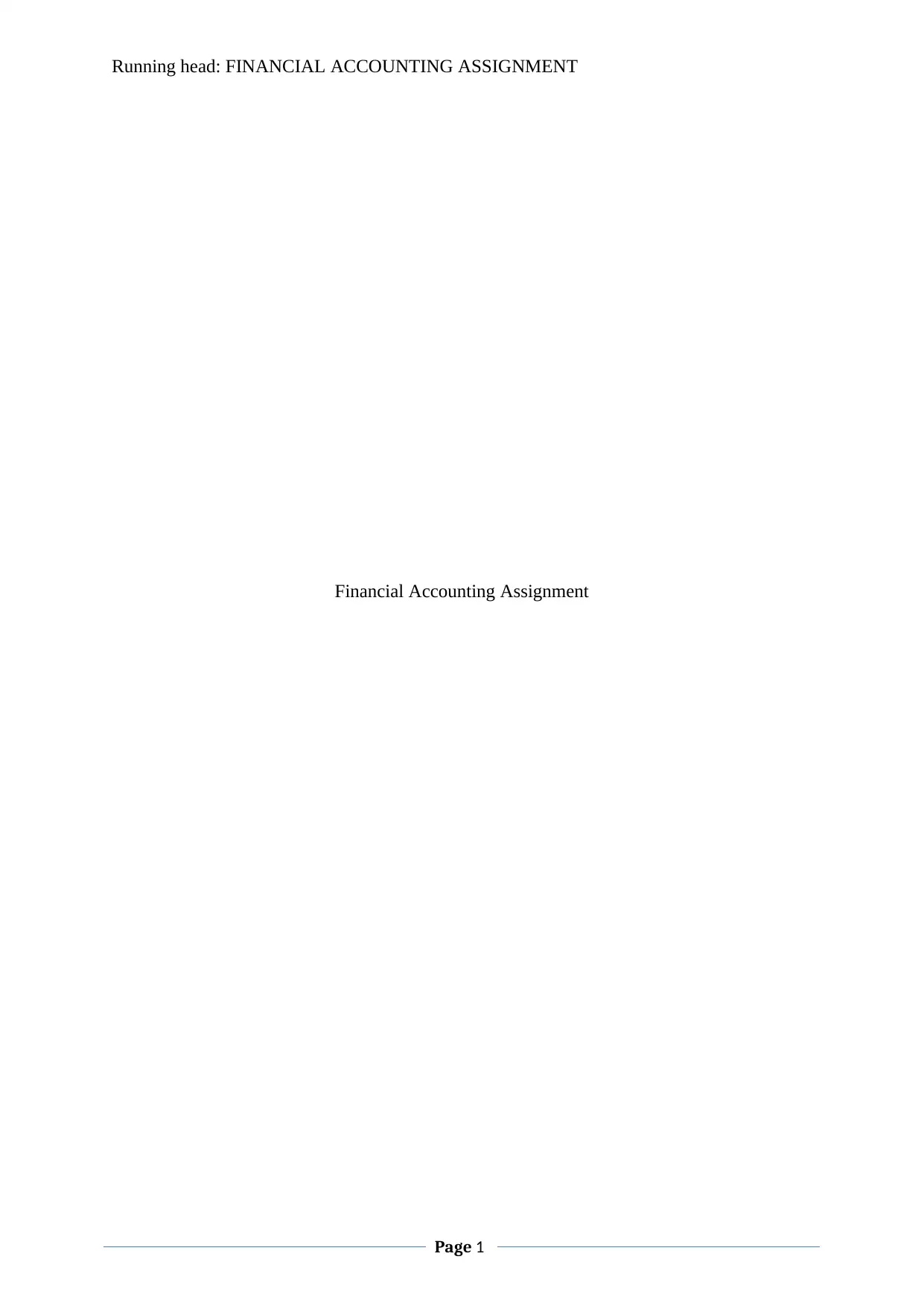
Running head: FINANCIAL ACCOUNTING ASSIGNMENT
Financial Accounting Assignment
Page 1
Financial Accounting Assignment
Page 1
Paraphrase This Document
Need a fresh take? Get an instant paraphrase of this document with our AI Paraphraser
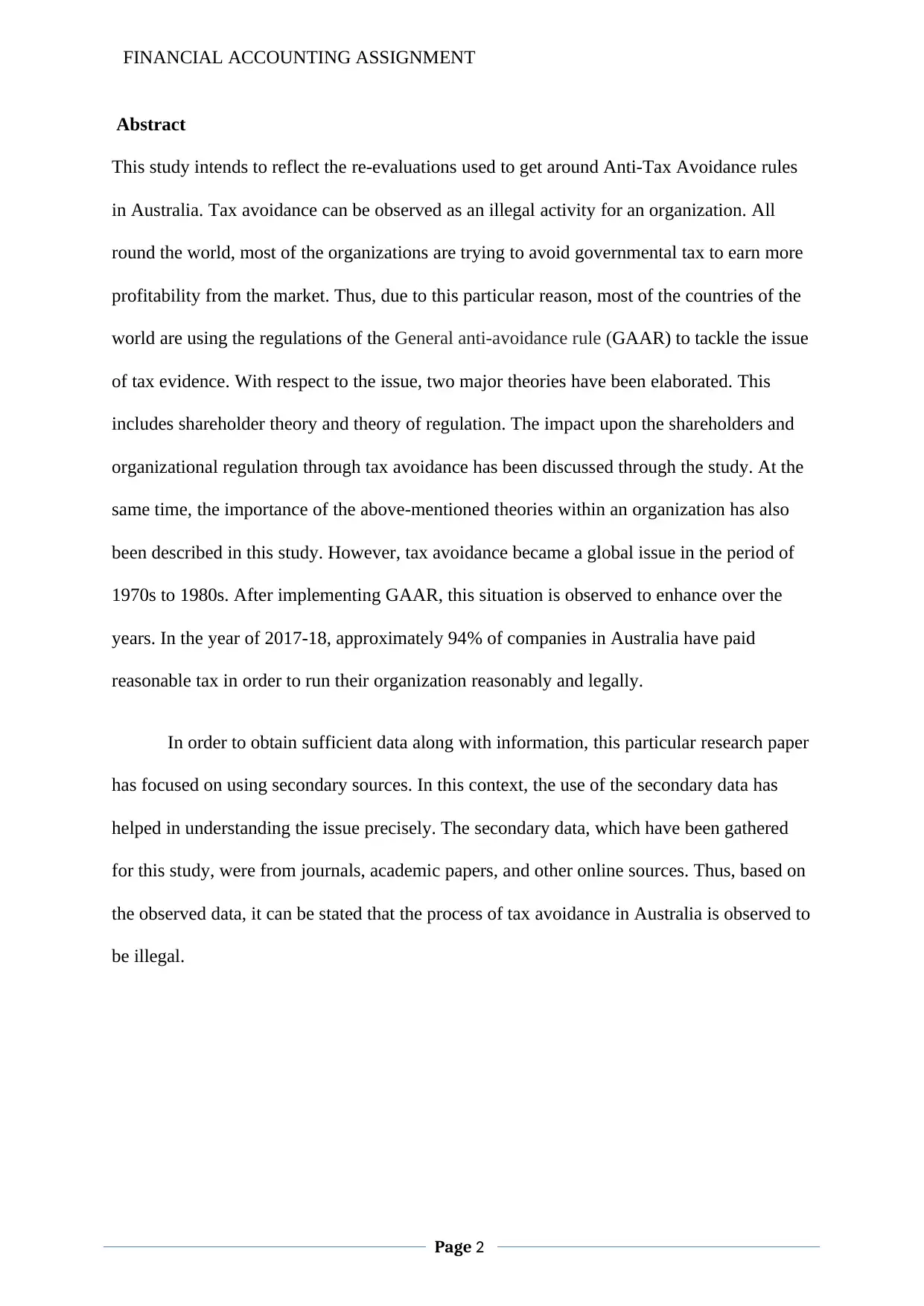
FINANCIAL ACCOUNTING ASSIGNMENT
Abstract
This study intends to reflect the re-evaluations used to get around Anti-Tax Avoidance rules
in Australia. Tax avoidance can be observed as an illegal activity for an organization. All
round the world, most of the organizations are trying to avoid governmental tax to earn more
profitability from the market. Thus, due to this particular reason, most of the countries of the
world are using the regulations of the General anti-avoidance rule (GAAR) to tackle the issue
of tax evidence. With respect to the issue, two major theories have been elaborated. This
includes shareholder theory and theory of regulation. The impact upon the shareholders and
organizational regulation through tax avoidance has been discussed through the study. At the
same time, the importance of the above-mentioned theories within an organization has also
been described in this study. However, tax avoidance became a global issue in the period of
1970s to 1980s. After implementing GAAR, this situation is observed to enhance over the
years. In the year of 2017-18, approximately 94% of companies in Australia have paid
reasonable tax in order to run their organization reasonably and legally.
In order to obtain sufficient data along with information, this particular research paper
has focused on using secondary sources. In this context, the use of the secondary data has
helped in understanding the issue precisely. The secondary data, which have been gathered
for this study, were from journals, academic papers, and other online sources. Thus, based on
the observed data, it can be stated that the process of tax avoidance in Australia is observed to
be illegal.
Page 2
Abstract
This study intends to reflect the re-evaluations used to get around Anti-Tax Avoidance rules
in Australia. Tax avoidance can be observed as an illegal activity for an organization. All
round the world, most of the organizations are trying to avoid governmental tax to earn more
profitability from the market. Thus, due to this particular reason, most of the countries of the
world are using the regulations of the General anti-avoidance rule (GAAR) to tackle the issue
of tax evidence. With respect to the issue, two major theories have been elaborated. This
includes shareholder theory and theory of regulation. The impact upon the shareholders and
organizational regulation through tax avoidance has been discussed through the study. At the
same time, the importance of the above-mentioned theories within an organization has also
been described in this study. However, tax avoidance became a global issue in the period of
1970s to 1980s. After implementing GAAR, this situation is observed to enhance over the
years. In the year of 2017-18, approximately 94% of companies in Australia have paid
reasonable tax in order to run their organization reasonably and legally.
In order to obtain sufficient data along with information, this particular research paper
has focused on using secondary sources. In this context, the use of the secondary data has
helped in understanding the issue precisely. The secondary data, which have been gathered
for this study, were from journals, academic papers, and other online sources. Thus, based on
the observed data, it can be stated that the process of tax avoidance in Australia is observed to
be illegal.
Page 2
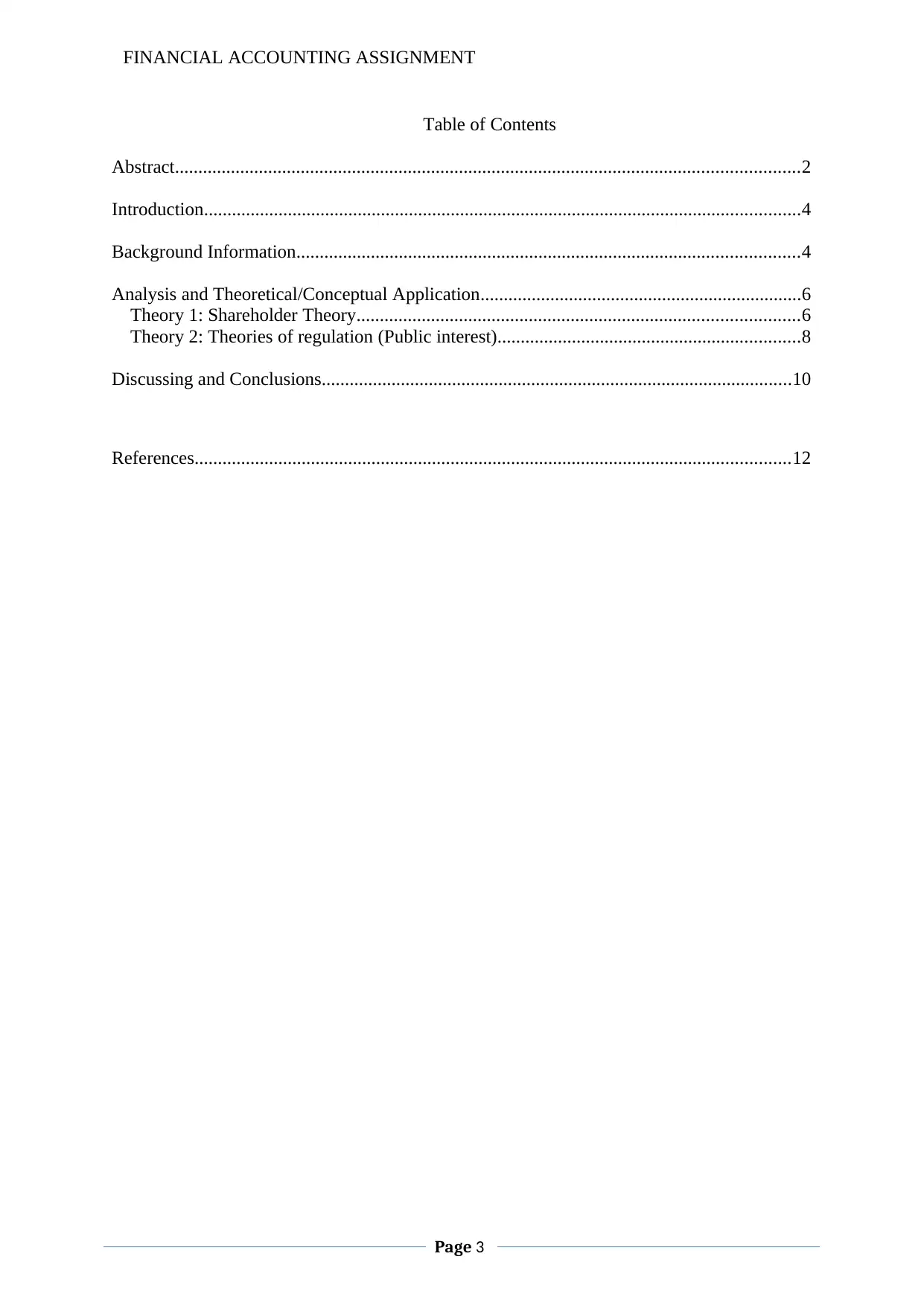
FINANCIAL ACCOUNTING ASSIGNMENT
Table of Contents
Abstract......................................................................................................................................2
Introduction................................................................................................................................4
Background Information............................................................................................................4
Analysis and Theoretical/Conceptual Application.....................................................................6
Theory 1: Shareholder Theory...............................................................................................6
Theory 2: Theories of regulation (Public interest).................................................................8
Discussing and Conclusions.....................................................................................................10
References................................................................................................................................12
Page 3
Table of Contents
Abstract......................................................................................................................................2
Introduction................................................................................................................................4
Background Information............................................................................................................4
Analysis and Theoretical/Conceptual Application.....................................................................6
Theory 1: Shareholder Theory...............................................................................................6
Theory 2: Theories of regulation (Public interest).................................................................8
Discussing and Conclusions.....................................................................................................10
References................................................................................................................................12
Page 3
⊘ This is a preview!⊘
Do you want full access?
Subscribe today to unlock all pages.

Trusted by 1+ million students worldwide
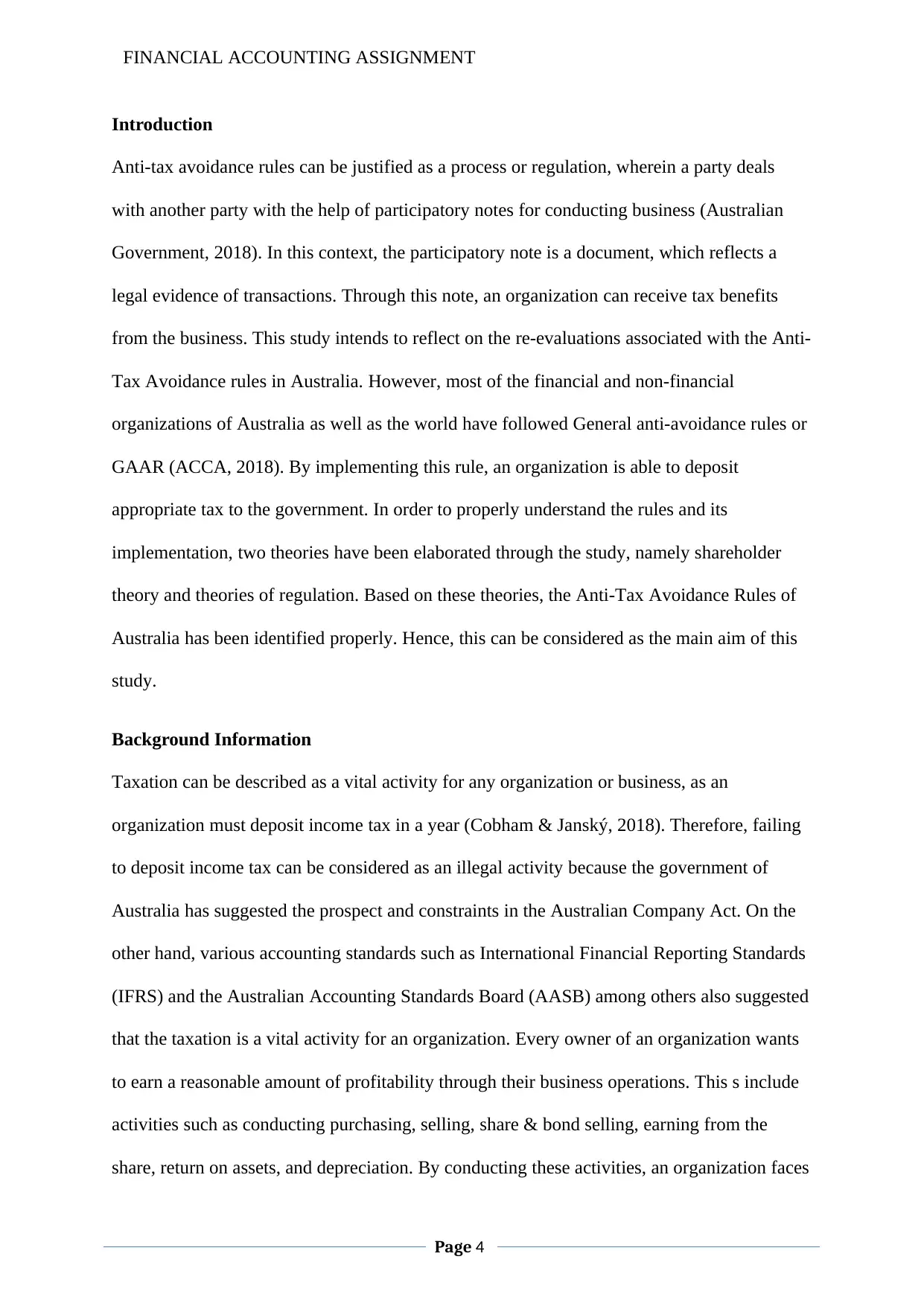
FINANCIAL ACCOUNTING ASSIGNMENT
Introduction
Anti-tax avoidance rules can be justified as a process or regulation, wherein a party deals
with another party with the help of participatory notes for conducting business (Australian
Government, 2018). In this context, the participatory note is a document, which reflects a
legal evidence of transactions. Through this note, an organization can receive tax benefits
from the business. This study intends to reflect on the re-evaluations associated with the Anti-
Tax Avoidance rules in Australia. However, most of the financial and non-financial
organizations of Australia as well as the world have followed General anti-avoidance rules or
GAAR (ACCA, 2018). By implementing this rule, an organization is able to deposit
appropriate tax to the government. In order to properly understand the rules and its
implementation, two theories have been elaborated through the study, namely shareholder
theory and theories of regulation. Based on these theories, the Anti-Tax Avoidance Rules of
Australia has been identified properly. Hence, this can be considered as the main aim of this
study.
Background Information
Taxation can be described as a vital activity for any organization or business, as an
organization must deposit income tax in a year (Cobham & Janský, 2018). Therefore, failing
to deposit income tax can be considered as an illegal activity because the government of
Australia has suggested the prospect and constraints in the Australian Company Act. On the
other hand, various accounting standards such as International Financial Reporting Standards
(IFRS) and the Australian Accounting Standards Board (AASB) among others also suggested
that the taxation is a vital activity for an organization. Every owner of an organization wants
to earn a reasonable amount of profitability through their business operations. This s include
activities such as conducting purchasing, selling, share & bond selling, earning from the
share, return on assets, and depreciation. By conducting these activities, an organization faces
Page 4
Introduction
Anti-tax avoidance rules can be justified as a process or regulation, wherein a party deals
with another party with the help of participatory notes for conducting business (Australian
Government, 2018). In this context, the participatory note is a document, which reflects a
legal evidence of transactions. Through this note, an organization can receive tax benefits
from the business. This study intends to reflect on the re-evaluations associated with the Anti-
Tax Avoidance rules in Australia. However, most of the financial and non-financial
organizations of Australia as well as the world have followed General anti-avoidance rules or
GAAR (ACCA, 2018). By implementing this rule, an organization is able to deposit
appropriate tax to the government. In order to properly understand the rules and its
implementation, two theories have been elaborated through the study, namely shareholder
theory and theories of regulation. Based on these theories, the Anti-Tax Avoidance Rules of
Australia has been identified properly. Hence, this can be considered as the main aim of this
study.
Background Information
Taxation can be described as a vital activity for any organization or business, as an
organization must deposit income tax in a year (Cobham & Janský, 2018). Therefore, failing
to deposit income tax can be considered as an illegal activity because the government of
Australia has suggested the prospect and constraints in the Australian Company Act. On the
other hand, various accounting standards such as International Financial Reporting Standards
(IFRS) and the Australian Accounting Standards Board (AASB) among others also suggested
that the taxation is a vital activity for an organization. Every owner of an organization wants
to earn a reasonable amount of profitability through their business operations. This s include
activities such as conducting purchasing, selling, share & bond selling, earning from the
share, return on assets, and depreciation. By conducting these activities, an organization faces
Page 4
Paraphrase This Document
Need a fresh take? Get an instant paraphrase of this document with our AI Paraphraser
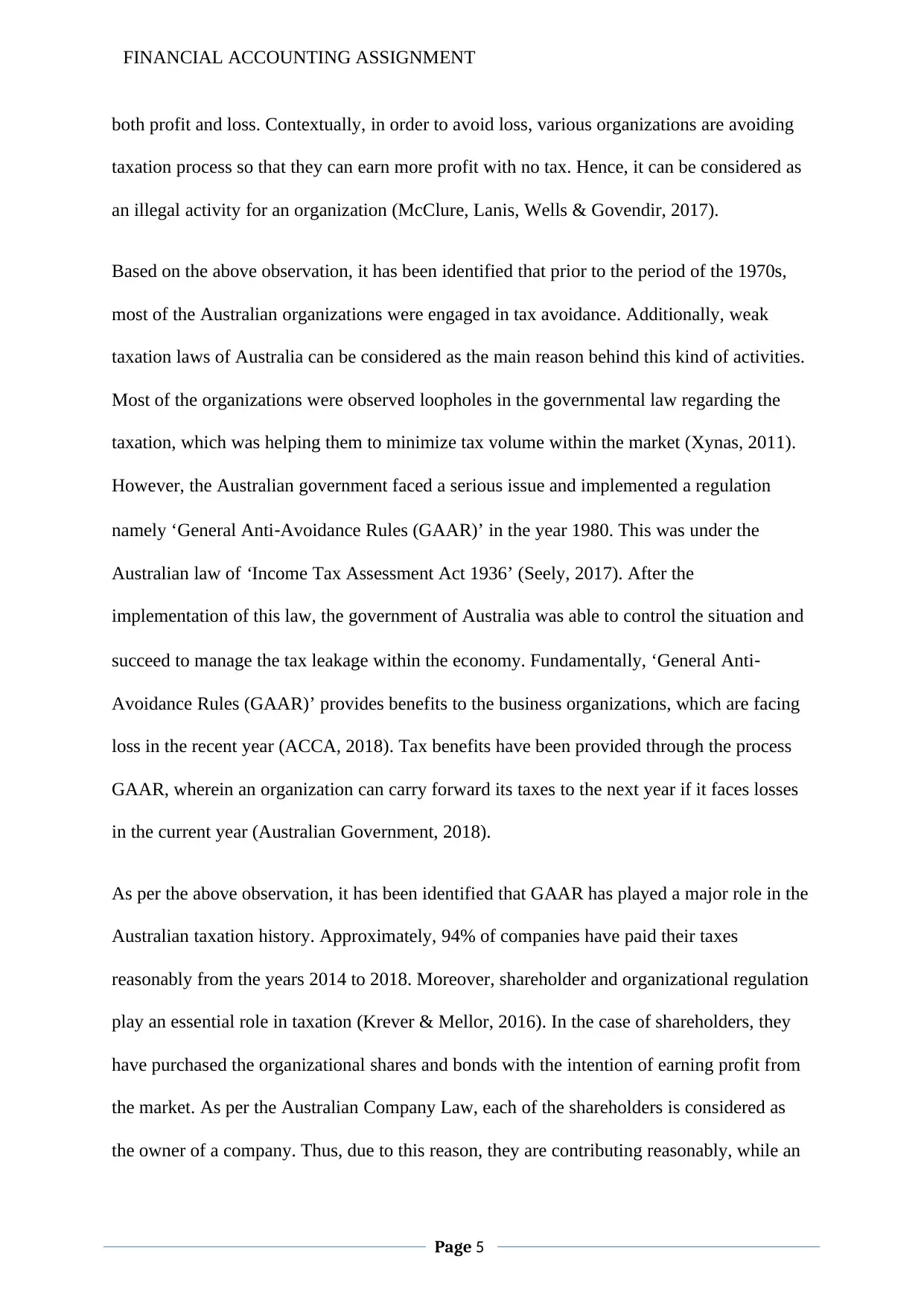
FINANCIAL ACCOUNTING ASSIGNMENT
both profit and loss. Contextually, in order to avoid loss, various organizations are avoiding
taxation process so that they can earn more profit with no tax. Hence, it can be considered as
an illegal activity for an organization (McClure, Lanis, Wells & Govendir, 2017).
Based on the above observation, it has been identified that prior to the period of the 1970s,
most of the Australian organizations were engaged in tax avoidance. Additionally, weak
taxation laws of Australia can be considered as the main reason behind this kind of activities.
Most of the organizations were observed loopholes in the governmental law regarding the
taxation, which was helping them to minimize tax volume within the market (Xynas, 2011).
However, the Australian government faced a serious issue and implemented a regulation
namely ‘General Anti‐Avoidance Rules (GAAR)’ in the year 1980. This was under the
Australian law of ‘Income Tax Assessment Act 1936’ (Seely, 2017). After the
implementation of this law, the government of Australia was able to control the situation and
succeed to manage the tax leakage within the economy. Fundamentally, ‘General Anti‐
Avoidance Rules (GAAR)’ provides benefits to the business organizations, which are facing
loss in the recent year (ACCA, 2018). Tax benefits have been provided through the process
GAAR, wherein an organization can carry forward its taxes to the next year if it faces losses
in the current year (Australian Government, 2018).
As per the above observation, it has been identified that GAAR has played a major role in the
Australian taxation history. Approximately, 94% of companies have paid their taxes
reasonably from the years 2014 to 2018. Moreover, shareholder and organizational regulation
play an essential role in taxation (Krever & Mellor, 2016). In the case of shareholders, they
have purchased the organizational shares and bonds with the intention of earning profit from
the market. As per the Australian Company Law, each of the shareholders is considered as
the owner of a company. Thus, due to this reason, they are contributing reasonably, while an
Page 5
both profit and loss. Contextually, in order to avoid loss, various organizations are avoiding
taxation process so that they can earn more profit with no tax. Hence, it can be considered as
an illegal activity for an organization (McClure, Lanis, Wells & Govendir, 2017).
Based on the above observation, it has been identified that prior to the period of the 1970s,
most of the Australian organizations were engaged in tax avoidance. Additionally, weak
taxation laws of Australia can be considered as the main reason behind this kind of activities.
Most of the organizations were observed loopholes in the governmental law regarding the
taxation, which was helping them to minimize tax volume within the market (Xynas, 2011).
However, the Australian government faced a serious issue and implemented a regulation
namely ‘General Anti‐Avoidance Rules (GAAR)’ in the year 1980. This was under the
Australian law of ‘Income Tax Assessment Act 1936’ (Seely, 2017). After the
implementation of this law, the government of Australia was able to control the situation and
succeed to manage the tax leakage within the economy. Fundamentally, ‘General Anti‐
Avoidance Rules (GAAR)’ provides benefits to the business organizations, which are facing
loss in the recent year (ACCA, 2018). Tax benefits have been provided through the process
GAAR, wherein an organization can carry forward its taxes to the next year if it faces losses
in the current year (Australian Government, 2018).
As per the above observation, it has been identified that GAAR has played a major role in the
Australian taxation history. Approximately, 94% of companies have paid their taxes
reasonably from the years 2014 to 2018. Moreover, shareholder and organizational regulation
play an essential role in taxation (Krever & Mellor, 2016). In the case of shareholders, they
have purchased the organizational shares and bonds with the intention of earning profit from
the market. As per the Australian Company Law, each of the shareholders is considered as
the owner of a company. Thus, due to this reason, they are contributing reasonably, while an
Page 5
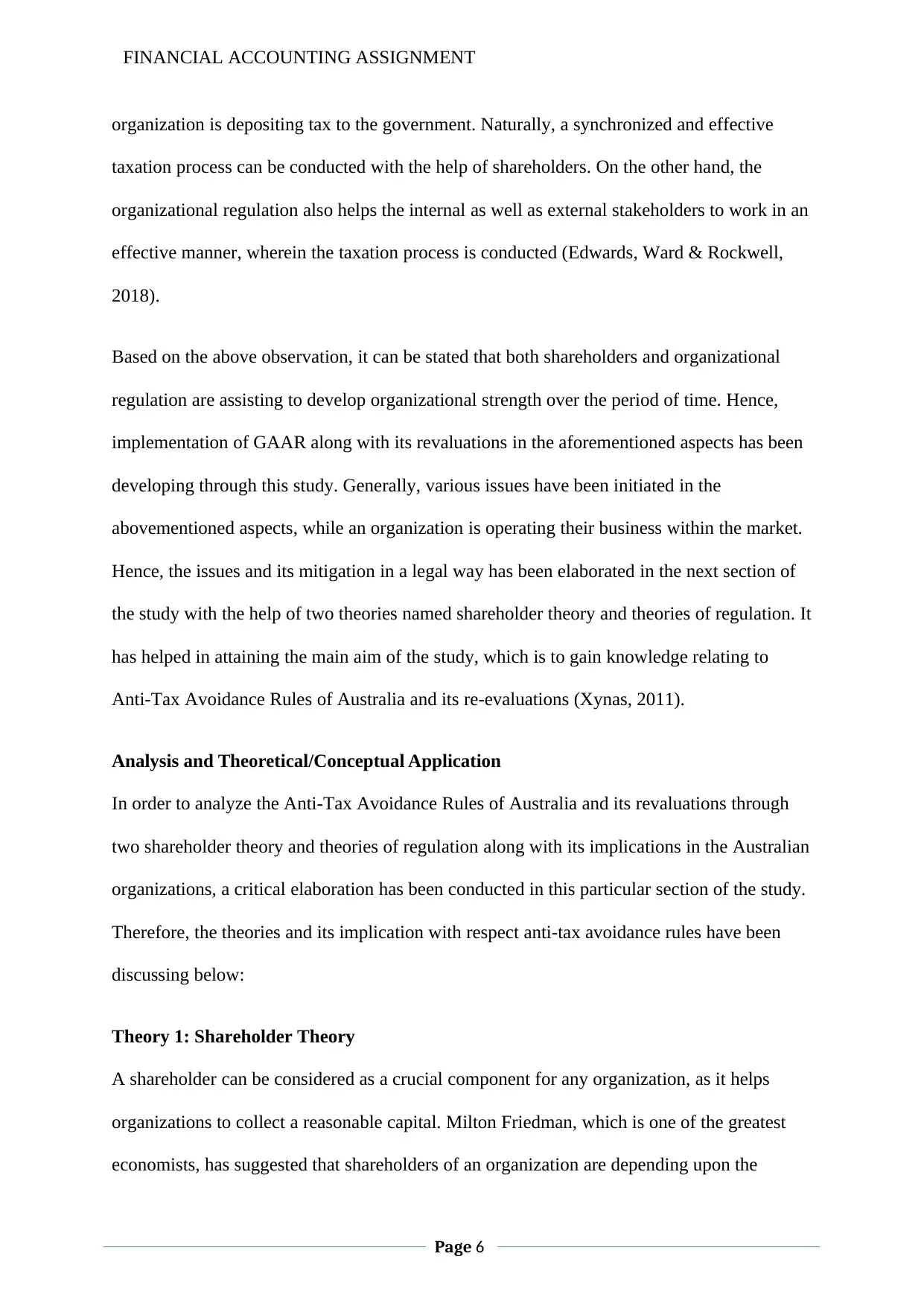
FINANCIAL ACCOUNTING ASSIGNMENT
organization is depositing tax to the government. Naturally, a synchronized and effective
taxation process can be conducted with the help of shareholders. On the other hand, the
organizational regulation also helps the internal as well as external stakeholders to work in an
effective manner, wherein the taxation process is conducted (Edwards, Ward & Rockwell,
2018).
Based on the above observation, it can be stated that both shareholders and organizational
regulation are assisting to develop organizational strength over the period of time. Hence,
implementation of GAAR along with its revaluations in the aforementioned aspects has been
developing through this study. Generally, various issues have been initiated in the
abovementioned aspects, while an organization is operating their business within the market.
Hence, the issues and its mitigation in a legal way has been elaborated in the next section of
the study with the help of two theories named shareholder theory and theories of regulation. It
has helped in attaining the main aim of the study, which is to gain knowledge relating to
Anti-Tax Avoidance Rules of Australia and its re-evaluations (Xynas, 2011).
Analysis and Theoretical/Conceptual Application
In order to analyze the Anti-Tax Avoidance Rules of Australia and its revaluations through
two shareholder theory and theories of regulation along with its implications in the Australian
organizations, a critical elaboration has been conducted in this particular section of the study.
Therefore, the theories and its implication with respect anti-tax avoidance rules have been
discussing below:
Theory 1: Shareholder Theory
A shareholder can be considered as a crucial component for any organization, as it helps
organizations to collect a reasonable capital. Milton Friedman, which is one of the greatest
economists, has suggested that shareholders of an organization are depending upon the
Page 6
organization is depositing tax to the government. Naturally, a synchronized and effective
taxation process can be conducted with the help of shareholders. On the other hand, the
organizational regulation also helps the internal as well as external stakeholders to work in an
effective manner, wherein the taxation process is conducted (Edwards, Ward & Rockwell,
2018).
Based on the above observation, it can be stated that both shareholders and organizational
regulation are assisting to develop organizational strength over the period of time. Hence,
implementation of GAAR along with its revaluations in the aforementioned aspects has been
developing through this study. Generally, various issues have been initiated in the
abovementioned aspects, while an organization is operating their business within the market.
Hence, the issues and its mitigation in a legal way has been elaborated in the next section of
the study with the help of two theories named shareholder theory and theories of regulation. It
has helped in attaining the main aim of the study, which is to gain knowledge relating to
Anti-Tax Avoidance Rules of Australia and its re-evaluations (Xynas, 2011).
Analysis and Theoretical/Conceptual Application
In order to analyze the Anti-Tax Avoidance Rules of Australia and its revaluations through
two shareholder theory and theories of regulation along with its implications in the Australian
organizations, a critical elaboration has been conducted in this particular section of the study.
Therefore, the theories and its implication with respect anti-tax avoidance rules have been
discussing below:
Theory 1: Shareholder Theory
A shareholder can be considered as a crucial component for any organization, as it helps
organizations to collect a reasonable capital. Milton Friedman, which is one of the greatest
economists, has suggested that shareholders of an organization are depending upon the
Page 6
⊘ This is a preview!⊘
Do you want full access?
Subscribe today to unlock all pages.

Trusted by 1+ million students worldwide
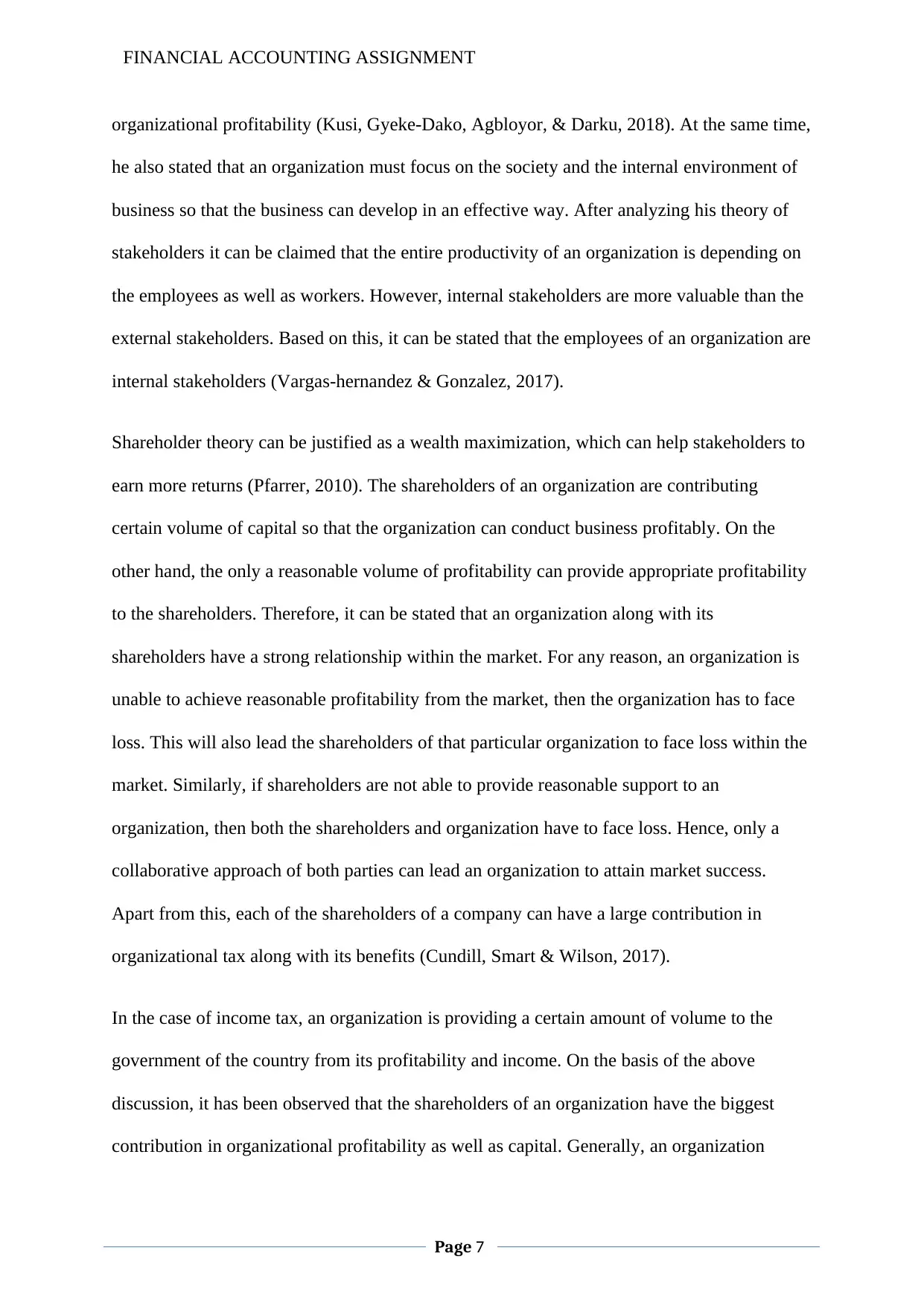
FINANCIAL ACCOUNTING ASSIGNMENT
organizational profitability (Kusi, Gyeke-Dako, Agbloyor, & Darku, 2018). At the same time,
he also stated that an organization must focus on the society and the internal environment of
business so that the business can develop in an effective way. After analyzing his theory of
stakeholders it can be claimed that the entire productivity of an organization is depending on
the employees as well as workers. However, internal stakeholders are more valuable than the
external stakeholders. Based on this, it can be stated that the employees of an organization are
internal stakeholders (Vargas-hernandez & Gonzalez, 2017).
Shareholder theory can be justified as a wealth maximization, which can help stakeholders to
earn more returns (Pfarrer, 2010). The shareholders of an organization are contributing
certain volume of capital so that the organization can conduct business profitably. On the
other hand, the only a reasonable volume of profitability can provide appropriate profitability
to the shareholders. Therefore, it can be stated that an organization along with its
shareholders have a strong relationship within the market. For any reason, an organization is
unable to achieve reasonable profitability from the market, then the organization has to face
loss. This will also lead the shareholders of that particular organization to face loss within the
market. Similarly, if shareholders are not able to provide reasonable support to an
organization, then both the shareholders and organization have to face loss. Hence, only a
collaborative approach of both parties can lead an organization to attain market success.
Apart from this, each of the shareholders of a company can have a large contribution in
organizational tax along with its benefits (Cundill, Smart & Wilson, 2017).
In the case of income tax, an organization is providing a certain amount of volume to the
government of the country from its profitability and income. On the basis of the above
discussion, it has been observed that the shareholders of an organization have the biggest
contribution in organizational profitability as well as capital. Generally, an organization
Page 7
organizational profitability (Kusi, Gyeke-Dako, Agbloyor, & Darku, 2018). At the same time,
he also stated that an organization must focus on the society and the internal environment of
business so that the business can develop in an effective way. After analyzing his theory of
stakeholders it can be claimed that the entire productivity of an organization is depending on
the employees as well as workers. However, internal stakeholders are more valuable than the
external stakeholders. Based on this, it can be stated that the employees of an organization are
internal stakeholders (Vargas-hernandez & Gonzalez, 2017).
Shareholder theory can be justified as a wealth maximization, which can help stakeholders to
earn more returns (Pfarrer, 2010). The shareholders of an organization are contributing
certain volume of capital so that the organization can conduct business profitably. On the
other hand, the only a reasonable volume of profitability can provide appropriate profitability
to the shareholders. Therefore, it can be stated that an organization along with its
shareholders have a strong relationship within the market. For any reason, an organization is
unable to achieve reasonable profitability from the market, then the organization has to face
loss. This will also lead the shareholders of that particular organization to face loss within the
market. Similarly, if shareholders are not able to provide reasonable support to an
organization, then both the shareholders and organization have to face loss. Hence, only a
collaborative approach of both parties can lead an organization to attain market success.
Apart from this, each of the shareholders of a company can have a large contribution in
organizational tax along with its benefits (Cundill, Smart & Wilson, 2017).
In the case of income tax, an organization is providing a certain amount of volume to the
government of the country from its profitability and income. On the basis of the above
discussion, it has been observed that the shareholders of an organization have the biggest
contribution in organizational profitability as well as capital. Generally, an organization
Page 7
Paraphrase This Document
Need a fresh take? Get an instant paraphrase of this document with our AI Paraphraser
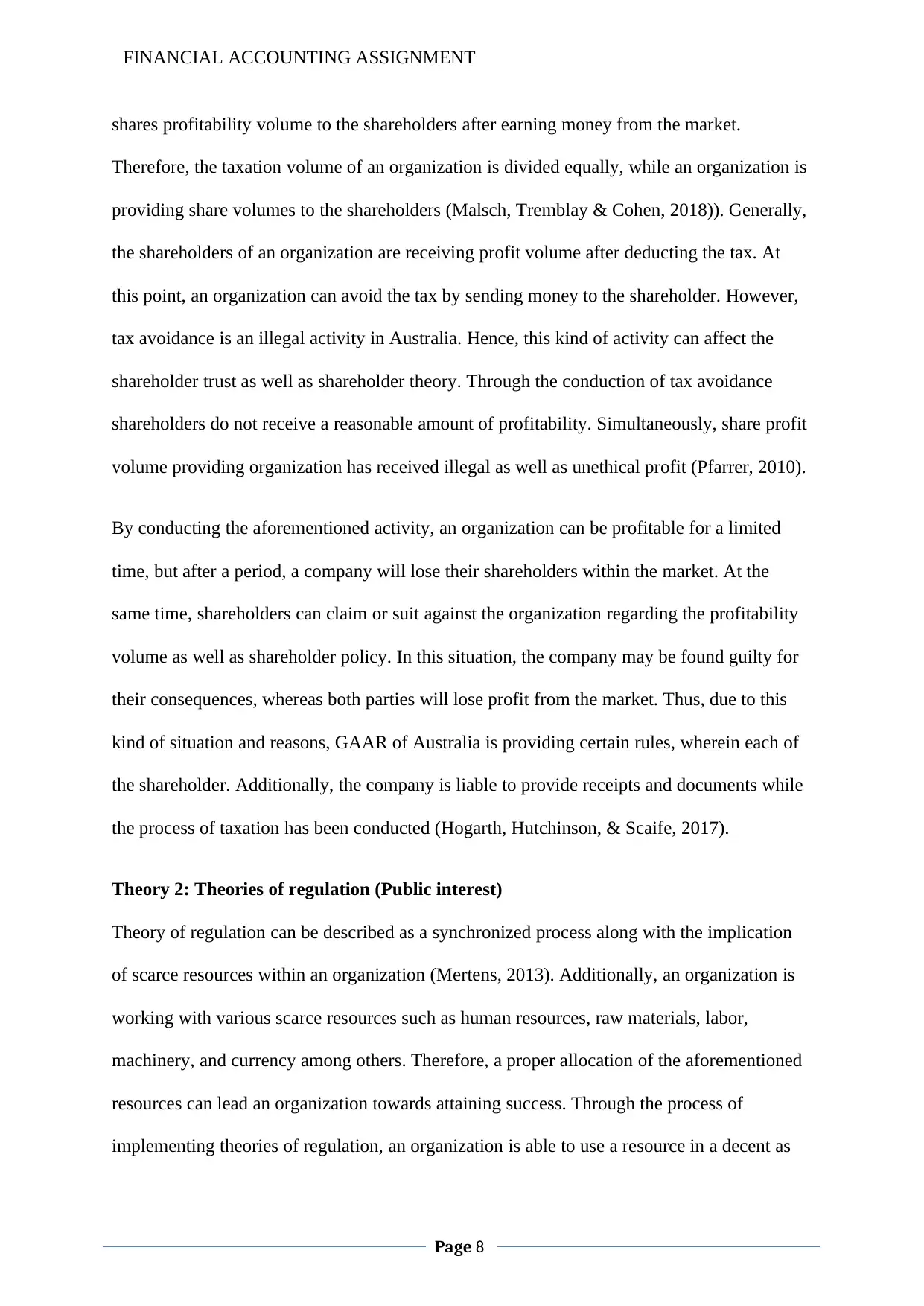
FINANCIAL ACCOUNTING ASSIGNMENT
shares profitability volume to the shareholders after earning money from the market.
Therefore, the taxation volume of an organization is divided equally, while an organization is
providing share volumes to the shareholders (Malsch, Tremblay & Cohen, 2018)). Generally,
the shareholders of an organization are receiving profit volume after deducting the tax. At
this point, an organization can avoid the tax by sending money to the shareholder. However,
tax avoidance is an illegal activity in Australia. Hence, this kind of activity can affect the
shareholder trust as well as shareholder theory. Through the conduction of tax avoidance
shareholders do not receive a reasonable amount of profitability. Simultaneously, share profit
volume providing organization has received illegal as well as unethical profit (Pfarrer, 2010).
By conducting the aforementioned activity, an organization can be profitable for a limited
time, but after a period, a company will lose their shareholders within the market. At the
same time, shareholders can claim or suit against the organization regarding the profitability
volume as well as shareholder policy. In this situation, the company may be found guilty for
their consequences, whereas both parties will lose profit from the market. Thus, due to this
kind of situation and reasons, GAAR of Australia is providing certain rules, wherein each of
the shareholder. Additionally, the company is liable to provide receipts and documents while
the process of taxation has been conducted (Hogarth, Hutchinson, & Scaife, 2017).
Theory 2: Theories of regulation (Public interest)
Theory of regulation can be described as a synchronized process along with the implication
of scarce resources within an organization (Mertens, 2013). Additionally, an organization is
working with various scarce resources such as human resources, raw materials, labor,
machinery, and currency among others. Therefore, a proper allocation of the aforementioned
resources can lead an organization towards attaining success. Through the process of
implementing theories of regulation, an organization is able to use a resource in a decent as
Page 8
shares profitability volume to the shareholders after earning money from the market.
Therefore, the taxation volume of an organization is divided equally, while an organization is
providing share volumes to the shareholders (Malsch, Tremblay & Cohen, 2018)). Generally,
the shareholders of an organization are receiving profit volume after deducting the tax. At
this point, an organization can avoid the tax by sending money to the shareholder. However,
tax avoidance is an illegal activity in Australia. Hence, this kind of activity can affect the
shareholder trust as well as shareholder theory. Through the conduction of tax avoidance
shareholders do not receive a reasonable amount of profitability. Simultaneously, share profit
volume providing organization has received illegal as well as unethical profit (Pfarrer, 2010).
By conducting the aforementioned activity, an organization can be profitable for a limited
time, but after a period, a company will lose their shareholders within the market. At the
same time, shareholders can claim or suit against the organization regarding the profitability
volume as well as shareholder policy. In this situation, the company may be found guilty for
their consequences, whereas both parties will lose profit from the market. Thus, due to this
kind of situation and reasons, GAAR of Australia is providing certain rules, wherein each of
the shareholder. Additionally, the company is liable to provide receipts and documents while
the process of taxation has been conducted (Hogarth, Hutchinson, & Scaife, 2017).
Theory 2: Theories of regulation (Public interest)
Theory of regulation can be described as a synchronized process along with the implication
of scarce resources within an organization (Mertens, 2013). Additionally, an organization is
working with various scarce resources such as human resources, raw materials, labor,
machinery, and currency among others. Therefore, a proper allocation of the aforementioned
resources can lead an organization towards attaining success. Through the process of
implementing theories of regulation, an organization is able to use a resource in a decent as
Page 8
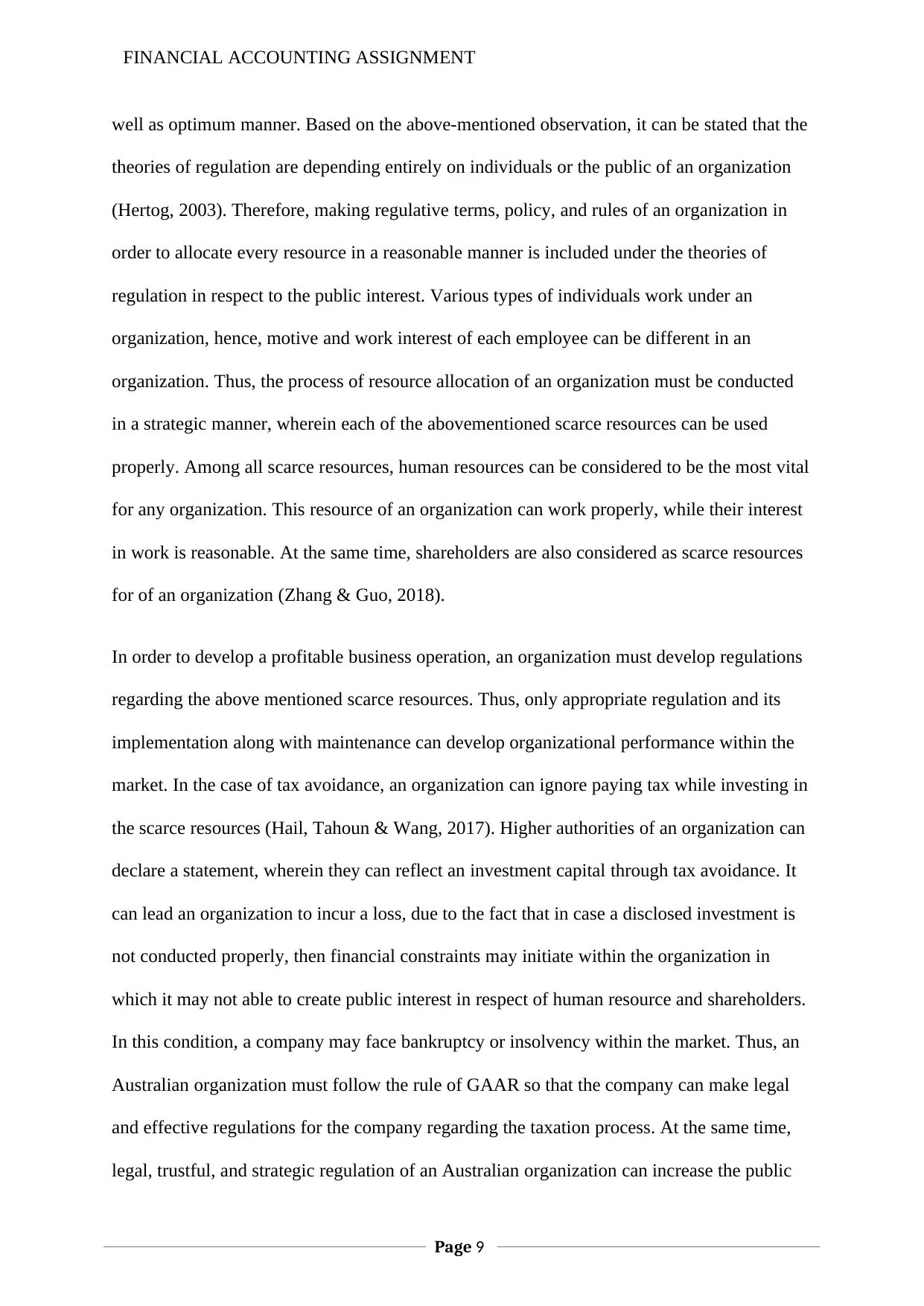
FINANCIAL ACCOUNTING ASSIGNMENT
well as optimum manner. Based on the above-mentioned observation, it can be stated that the
theories of regulation are depending entirely on individuals or the public of an organization
(Hertog, 2003). Therefore, making regulative terms, policy, and rules of an organization in
order to allocate every resource in a reasonable manner is included under the theories of
regulation in respect to the public interest. Various types of individuals work under an
organization, hence, motive and work interest of each employee can be different in an
organization. Thus, the process of resource allocation of an organization must be conducted
in a strategic manner, wherein each of the abovementioned scarce resources can be used
properly. Among all scarce resources, human resources can be considered to be the most vital
for any organization. This resource of an organization can work properly, while their interest
in work is reasonable. At the same time, shareholders are also considered as scarce resources
for of an organization (Zhang & Guo, 2018).
In order to develop a profitable business operation, an organization must develop regulations
regarding the above mentioned scarce resources. Thus, only appropriate regulation and its
implementation along with maintenance can develop organizational performance within the
market. In the case of tax avoidance, an organization can ignore paying tax while investing in
the scarce resources (Hail, Tahoun & Wang, 2017). Higher authorities of an organization can
declare a statement, wherein they can reflect an investment capital through tax avoidance. It
can lead an organization to incur a loss, due to the fact that in case a disclosed investment is
not conducted properly, then financial constraints may initiate within the organization in
which it may not able to create public interest in respect of human resource and shareholders.
In this condition, a company may face bankruptcy or insolvency within the market. Thus, an
Australian organization must follow the rule of GAAR so that the company can make legal
and effective regulations for the company regarding the taxation process. At the same time,
legal, trustful, and strategic regulation of an Australian organization can increase the public
Page 9
well as optimum manner. Based on the above-mentioned observation, it can be stated that the
theories of regulation are depending entirely on individuals or the public of an organization
(Hertog, 2003). Therefore, making regulative terms, policy, and rules of an organization in
order to allocate every resource in a reasonable manner is included under the theories of
regulation in respect to the public interest. Various types of individuals work under an
organization, hence, motive and work interest of each employee can be different in an
organization. Thus, the process of resource allocation of an organization must be conducted
in a strategic manner, wherein each of the abovementioned scarce resources can be used
properly. Among all scarce resources, human resources can be considered to be the most vital
for any organization. This resource of an organization can work properly, while their interest
in work is reasonable. At the same time, shareholders are also considered as scarce resources
for of an organization (Zhang & Guo, 2018).
In order to develop a profitable business operation, an organization must develop regulations
regarding the above mentioned scarce resources. Thus, only appropriate regulation and its
implementation along with maintenance can develop organizational performance within the
market. In the case of tax avoidance, an organization can ignore paying tax while investing in
the scarce resources (Hail, Tahoun & Wang, 2017). Higher authorities of an organization can
declare a statement, wherein they can reflect an investment capital through tax avoidance. It
can lead an organization to incur a loss, due to the fact that in case a disclosed investment is
not conducted properly, then financial constraints may initiate within the organization in
which it may not able to create public interest in respect of human resource and shareholders.
In this condition, a company may face bankruptcy or insolvency within the market. Thus, an
Australian organization must follow the rule of GAAR so that the company can make legal
and effective regulations for the company regarding the taxation process. At the same time,
legal, trustful, and strategic regulation of an Australian organization can increase the public
Page 9
⊘ This is a preview!⊘
Do you want full access?
Subscribe today to unlock all pages.

Trusted by 1+ million students worldwide
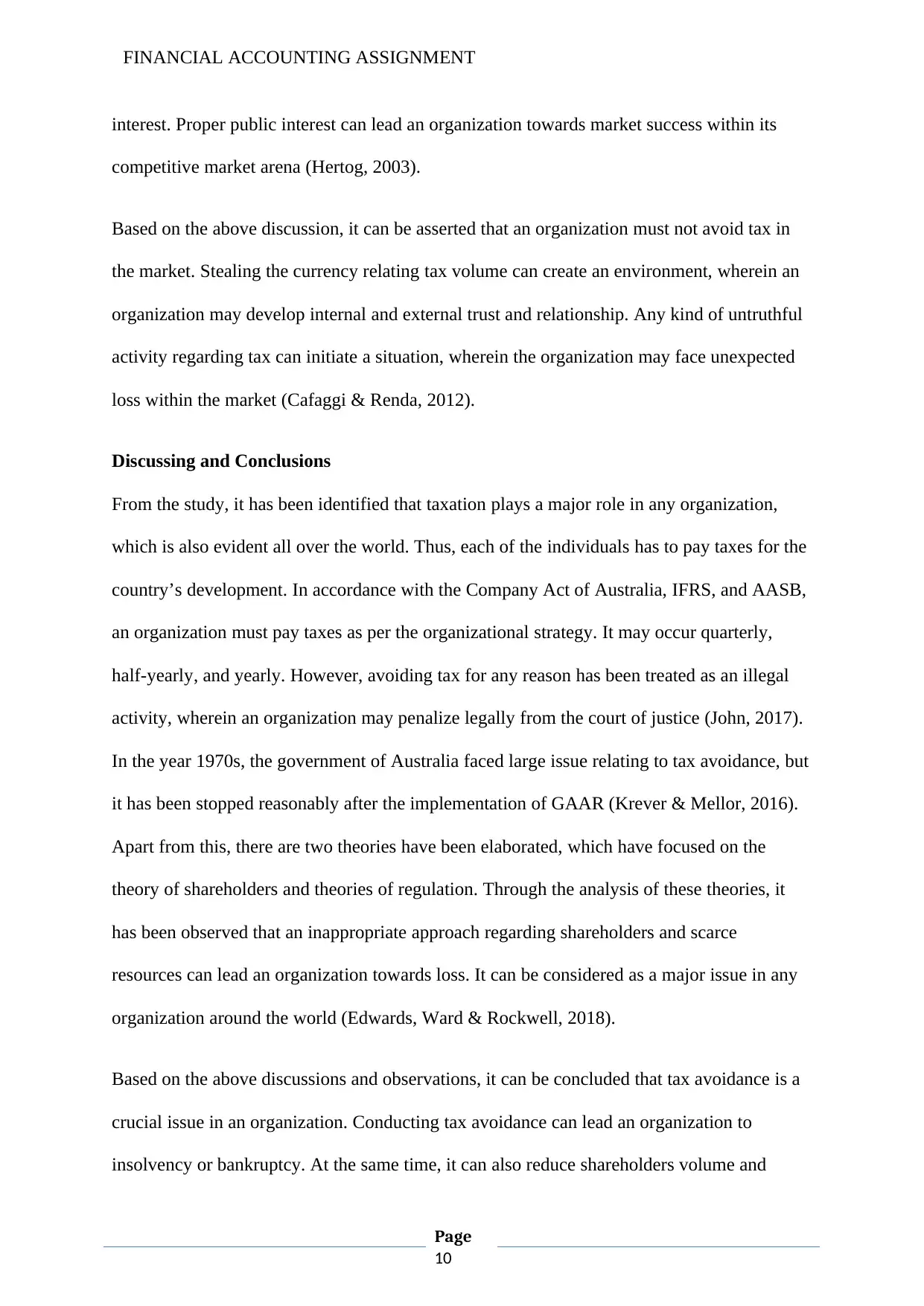
FINANCIAL ACCOUNTING ASSIGNMENT
interest. Proper public interest can lead an organization towards market success within its
competitive market arena (Hertog, 2003).
Based on the above discussion, it can be asserted that an organization must not avoid tax in
the market. Stealing the currency relating tax volume can create an environment, wherein an
organization may develop internal and external trust and relationship. Any kind of untruthful
activity regarding tax can initiate a situation, wherein the organization may face unexpected
loss within the market (Cafaggi & Renda, 2012).
Discussing and Conclusions
From the study, it has been identified that taxation plays a major role in any organization,
which is also evident all over the world. Thus, each of the individuals has to pay taxes for the
country’s development. In accordance with the Company Act of Australia, IFRS, and AASB,
an organization must pay taxes as per the organizational strategy. It may occur quarterly,
half-yearly, and yearly. However, avoiding tax for any reason has been treated as an illegal
activity, wherein an organization may penalize legally from the court of justice (John, 2017).
In the year 1970s, the government of Australia faced large issue relating to tax avoidance, but
it has been stopped reasonably after the implementation of GAAR (Krever & Mellor, 2016).
Apart from this, there are two theories have been elaborated, which have focused on the
theory of shareholders and theories of regulation. Through the analysis of these theories, it
has been observed that an inappropriate approach regarding shareholders and scarce
resources can lead an organization towards loss. It can be considered as a major issue in any
organization around the world (Edwards, Ward & Rockwell, 2018).
Based on the above discussions and observations, it can be concluded that tax avoidance is a
crucial issue in an organization. Conducting tax avoidance can lead an organization to
insolvency or bankruptcy. At the same time, it can also reduce shareholders volume and
Page
10
interest. Proper public interest can lead an organization towards market success within its
competitive market arena (Hertog, 2003).
Based on the above discussion, it can be asserted that an organization must not avoid tax in
the market. Stealing the currency relating tax volume can create an environment, wherein an
organization may develop internal and external trust and relationship. Any kind of untruthful
activity regarding tax can initiate a situation, wherein the organization may face unexpected
loss within the market (Cafaggi & Renda, 2012).
Discussing and Conclusions
From the study, it has been identified that taxation plays a major role in any organization,
which is also evident all over the world. Thus, each of the individuals has to pay taxes for the
country’s development. In accordance with the Company Act of Australia, IFRS, and AASB,
an organization must pay taxes as per the organizational strategy. It may occur quarterly,
half-yearly, and yearly. However, avoiding tax for any reason has been treated as an illegal
activity, wherein an organization may penalize legally from the court of justice (John, 2017).
In the year 1970s, the government of Australia faced large issue relating to tax avoidance, but
it has been stopped reasonably after the implementation of GAAR (Krever & Mellor, 2016).
Apart from this, there are two theories have been elaborated, which have focused on the
theory of shareholders and theories of regulation. Through the analysis of these theories, it
has been observed that an inappropriate approach regarding shareholders and scarce
resources can lead an organization towards loss. It can be considered as a major issue in any
organization around the world (Edwards, Ward & Rockwell, 2018).
Based on the above discussions and observations, it can be concluded that tax avoidance is a
crucial issue in an organization. Conducting tax avoidance can lead an organization to
insolvency or bankruptcy. At the same time, it can also reduce shareholders volume and
Page
10
Paraphrase This Document
Need a fresh take? Get an instant paraphrase of this document with our AI Paraphraser
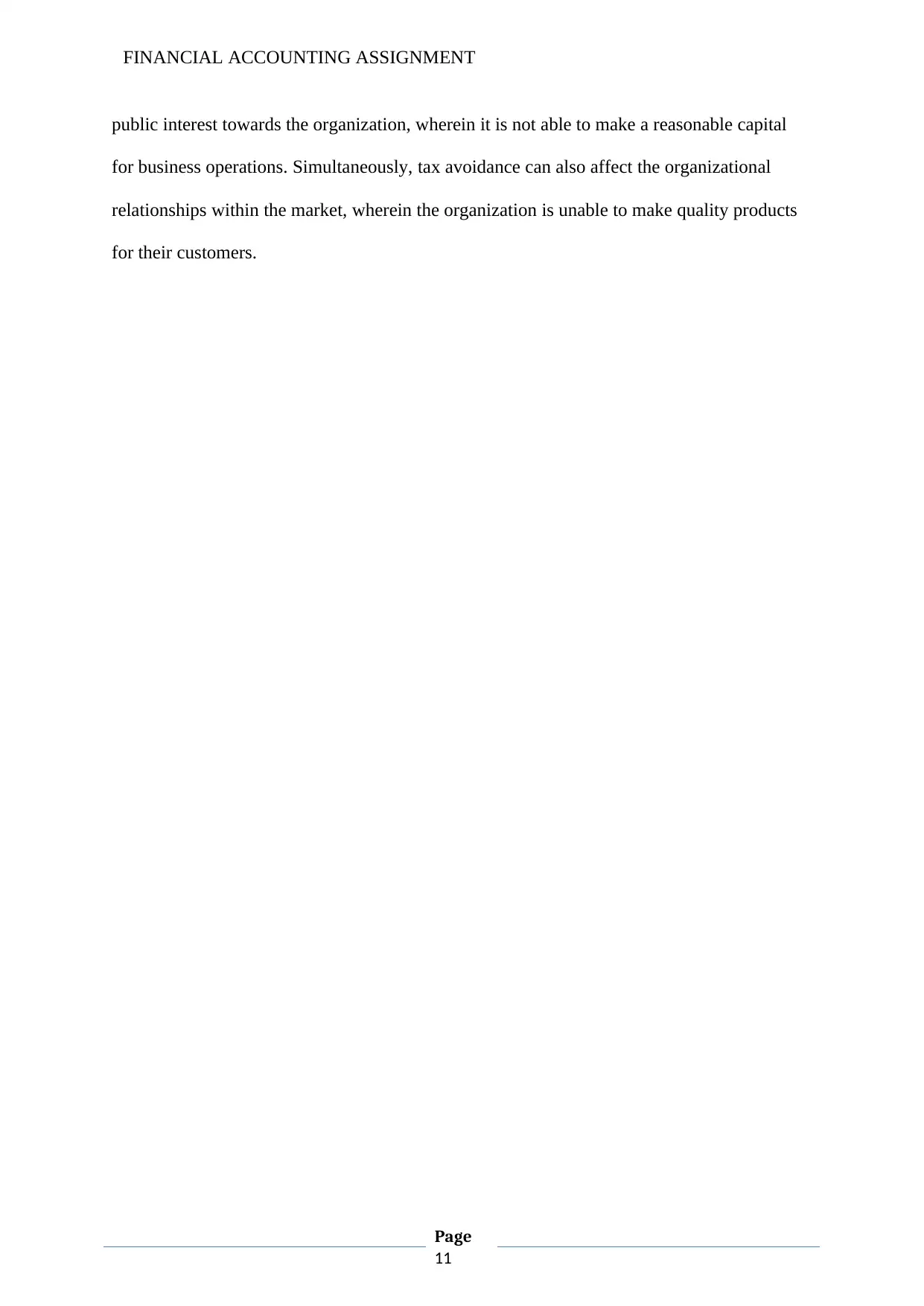
FINANCIAL ACCOUNTING ASSIGNMENT
public interest towards the organization, wherein it is not able to make a reasonable capital
for business operations. Simultaneously, tax avoidance can also affect the organizational
relationships within the market, wherein the organization is unable to make quality products
for their customers.
Page
11
public interest towards the organization, wherein it is not able to make a reasonable capital
for business operations. Simultaneously, tax avoidance can also affect the organizational
relationships within the market, wherein the organization is unable to make quality products
for their customers.
Page
11
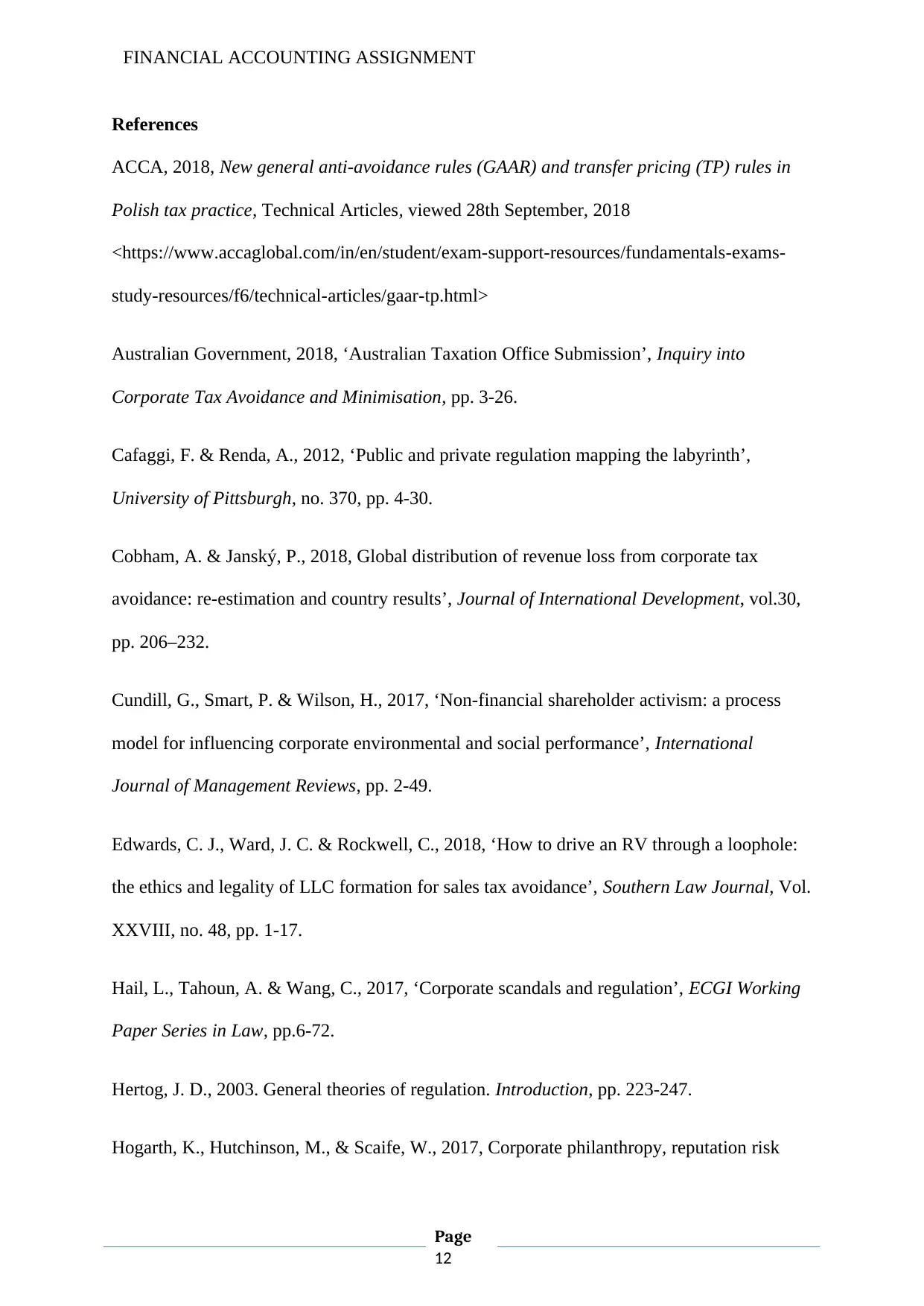
FINANCIAL ACCOUNTING ASSIGNMENT
References
ACCA, 2018, New general anti-avoidance rules (GAAR) and transfer pricing (TP) rules in
Polish tax practice, Technical Articles, viewed 28th September, 2018
<https://www.accaglobal.com/in/en/student/exam-support-resources/fundamentals-exams-
study-resources/f6/technical-articles/gaar-tp.html>
Australian Government, 2018, ‘Australian Taxation Office Submission’, Inquiry into
Corporate Tax Avoidance and Minimisation, pp. 3-26.
Cafaggi, F. & Renda, A., 2012, ‘Public and private regulation mapping the labyrinth’,
University of Pittsburgh, no. 370, pp. 4-30.
Cobham, A. & Janský, P., 2018, Global distribution of revenue loss from corporate tax
avoidance: re-estimation and country results’, Journal of International Development, vol.30,
pp. 206–232.
Cundill, G., Smart, P. & Wilson, H., 2017, ‘Non-financial shareholder activism: a process
model for influencing corporate environmental and social performance’, International
Journal of Management Reviews, pp. 2-49.
Edwards, C. J., Ward, J. C. & Rockwell, C., 2018, ‘How to drive an RV through a loophole:
the ethics and legality of LLC formation for sales tax avoidance’, Southern Law Journal, Vol.
XXVIII, no. 48, pp. 1-17.
Hail, L., Tahoun, A. & Wang, C., 2017, ‘Corporate scandals and regulation’, ECGI Working
Paper Series in Law, pp.6-72.
Hertog, J. D., 2003. General theories of regulation. Introduction, pp. 223-247.
Hogarth, K., Hutchinson, M., & Scaife, W., 2017, Corporate philanthropy, reputation risk
Page
12
References
ACCA, 2018, New general anti-avoidance rules (GAAR) and transfer pricing (TP) rules in
Polish tax practice, Technical Articles, viewed 28th September, 2018
<https://www.accaglobal.com/in/en/student/exam-support-resources/fundamentals-exams-
study-resources/f6/technical-articles/gaar-tp.html>
Australian Government, 2018, ‘Australian Taxation Office Submission’, Inquiry into
Corporate Tax Avoidance and Minimisation, pp. 3-26.
Cafaggi, F. & Renda, A., 2012, ‘Public and private regulation mapping the labyrinth’,
University of Pittsburgh, no. 370, pp. 4-30.
Cobham, A. & Janský, P., 2018, Global distribution of revenue loss from corporate tax
avoidance: re-estimation and country results’, Journal of International Development, vol.30,
pp. 206–232.
Cundill, G., Smart, P. & Wilson, H., 2017, ‘Non-financial shareholder activism: a process
model for influencing corporate environmental and social performance’, International
Journal of Management Reviews, pp. 2-49.
Edwards, C. J., Ward, J. C. & Rockwell, C., 2018, ‘How to drive an RV through a loophole:
the ethics and legality of LLC formation for sales tax avoidance’, Southern Law Journal, Vol.
XXVIII, no. 48, pp. 1-17.
Hail, L., Tahoun, A. & Wang, C., 2017, ‘Corporate scandals and regulation’, ECGI Working
Paper Series in Law, pp.6-72.
Hertog, J. D., 2003. General theories of regulation. Introduction, pp. 223-247.
Hogarth, K., Hutchinson, M., & Scaife, W., 2017, Corporate philanthropy, reputation risk
Page
12
⊘ This is a preview!⊘
Do you want full access?
Subscribe today to unlock all pages.

Trusted by 1+ million students worldwide
1 out of 14
Your All-in-One AI-Powered Toolkit for Academic Success.
+13062052269
info@desklib.com
Available 24*7 on WhatsApp / Email
![[object Object]](/_next/static/media/star-bottom.7253800d.svg)
Unlock your academic potential
Copyright © 2020–2025 A2Z Services. All Rights Reserved. Developed and managed by ZUCOL.

